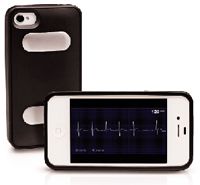Leading Off: An app that does the heart good
Dr. Barret Bulmer examines a handy tool for your iPhone that lets you record ECGs.
What limits recording of electrocardiograms (ECGs) in your practice? If you are like many practitioners, it is probably a combination of time limitations, the difficulty of digging the ECG machine out of the depths of storage, and the lack of patient cooperation as you attach the alligator clips—coupled with a rusty memory of how to actually interpret the recorded ECG. The AliveCor Veterinary Heart Monitor (alivecorvet.com) aims to help resolve these obstacles.

A many-splendored app: How it works
This simple but powerful single-lead ECG recording system is composed of an iPhone 4/4S case with two electrodes on the back of the case and a downloadable app. Simply insert your iPhone 4/4S into the case and, after downloading the AliveECG Vet application, commence ECG recording.
In most circumstances, the left side of the animal's chest is wiped with alcohol, and the electrodes are gently placed parallel to the long axis of the heart against the animal's chest. In some circumstances, the ECG may be able to be recorded even via electrode contact with the animal's paws.
Recording and display of the ECG on the iPhone's screen begin immediately after good skin contact is obtained. Recording time is programmable in increments of 30 seconds or can be set to continuous recording. The sensitivity and "paper" speed can be altered within the application for optimization of the ECG trace.
Acquisition ends after skin contact is disengaged, and the file can be stored on the iPhone alone, or it can be automatically sent for cloud storage, enabling review on any Internet-connected computer. Files may be emailed, printed, or viewed as a PDF from within the application.
The heart of the matter: How well does it work?
Acquisition of ECG tracings is easily achieved, and in most cases the signal strength and recording quality are very good. As with any ECG system, baseline artifact may be introduced by panting and movement, and in some circumstances the small amplitude P waves are difficult to consistently visualize.
Thus, this system is not meant to replace a multi-lead ECG that enables assessment of chamber enlargement, prolongation of conduction times, or S-T segment depression. But the system is useful on a daily basis for its accessibility and portability, its ease of use, its good recording quality, and, perhaps most important, its utility in the assessment of basic cardiac arrhythmias.
Although the system cannot interpret the ECG recording on its own, the key to ECG interpretation is practice, and this system enables easy recording of an infinite number of ECGs to help you hone your interpretive skills. The system is currently undergoing clinical validation by Marc Kraus, DVM, DACVIM (internal medicine, cardiology), in dogs, cats, and horses.
This "Leading Off" was provided by Barret Bulmer, DVM, MS, DACVIM (cardiology), Tufts Veterinary Emergency Treatment & Specialties, Walpole, Mass.

Barret Bulmer, DVM, MS, DACVIM
Podcast CE: Canine cardiology: the practical guide to the mitral valve patient
July 19th 2023Learn about the prevalence of myxomatous mitral valve disease, guidelines for staging heart disease, proactive diagnostic workup, the importance of spironolactone and aldosterone blocking, and the benefits of combination therapy for improved outcomes in canine patients
Listen
Oral solution approved by the FDA for canine heart failure
November 22nd 2024Vetmedin Solution from Boehringer Ingelheim is indicated for treatment of cases caused by myxomatous mitral valve disease or dilated cardiomyopathy and is the first oral solution approved by the FDA for this use in dogs
Read More